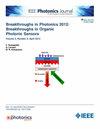Hybrid Data Augmentation Method for Multimode Sensing in a Whispering Gallery Mode Resonator
IF 2.4
4区 工程技术
Q3 ENGINEERING, ELECTRICAL & ELECTRONIC
引用次数: 0
Abstract
Multimode sensing based on whispering gallery mode (WGM) microcavities has attracted significant attention due to its diverse optical modes, which offer the potential for enhanced sensing performance. While AI models excel at integrating multimodal information, their effectiveness in multimode detection is often limited by the scarcity of large-scale, high-quality training data. To address this issue, we propose a hybrid data augmentation (DA) method that leverages an autoencoder (AE) to generate high-quality synthetic spectral data. Small Gaussian noise is then added to both real experimental and synthetic spectra, creating a large number of optical spectra sets. This significantly expands the training set, thereby improving the regression model’s accuracy and reducing overfitting. When applied to a multimode temperature regression task using a microbubble resonator (MBR), the hybrid DA method results in a 85.91% improvement in the prediction accuracy of the deep neural network (DNN). This approach is simple, efficient, and well-suited for multi-parameter regression tasks.窃窃廊谐振器中多模传感的混合数据增强方法
基于窃窃廊模式(WGM)微腔的多模传感技术因其具有多种光学模式而备受关注,为提高传感性能提供了潜力。虽然人工智能模型擅长整合多模态信息,但它们在多模态检测中的有效性往往受到大规模、高质量训练数据缺乏的限制。为了解决这个问题,我们提出了一种混合数据增强(DA)方法,该方法利用自动编码器(AE)来生成高质量的合成光谱数据。然后在真实的实验光谱和合成光谱中加入小的高斯噪声,形成大量的光谱集。这大大扩展了训练集,从而提高了回归模型的准确性,减少了过拟合。将混合数据分析方法应用于基于微泡谐振器(MBR)的多模温度回归任务中,深层神经网络(DNN)的预测精度提高了85.91%。这种方法简单、有效,非常适合于多参数回归任务。
本文章由计算机程序翻译,如有差异,请以英文原文为准。
求助全文
约1分钟内获得全文
求助全文
来源期刊

IEEE Photonics Journal
ENGINEERING, ELECTRICAL & ELECTRONIC-OPTICS
CiteScore
4.50
自引率
8.30%
发文量
489
审稿时长
1.4 months
期刊介绍:
Breakthroughs in the generation of light and in its control and utilization have given rise to the field of Photonics, a rapidly expanding area of science and technology with major technological and economic impact. Photonics integrates quantum electronics and optics to accelerate progress in the generation of novel photon sources and in their utilization in emerging applications at the micro and nano scales spanning from the far-infrared/THz to the x-ray region of the electromagnetic spectrum. IEEE Photonics Journal is an online-only journal dedicated to the rapid disclosure of top-quality peer-reviewed research at the forefront of all areas of photonics. Contributions addressing issues ranging from fundamental understanding to emerging technologies and applications are within the scope of the Journal. The Journal includes topics in: Photon sources from far infrared to X-rays, Photonics materials and engineered photonic structures, Integrated optics and optoelectronic, Ultrafast, attosecond, high field and short wavelength photonics, Biophotonics, including DNA photonics, Nanophotonics, Magnetophotonics, Fundamentals of light propagation and interaction; nonlinear effects, Optical data storage, Fiber optics and optical communications devices, systems, and technologies, Micro Opto Electro Mechanical Systems (MOEMS), Microwave photonics, Optical Sensors.
 求助内容:
求助内容: 应助结果提醒方式:
应助结果提醒方式:


